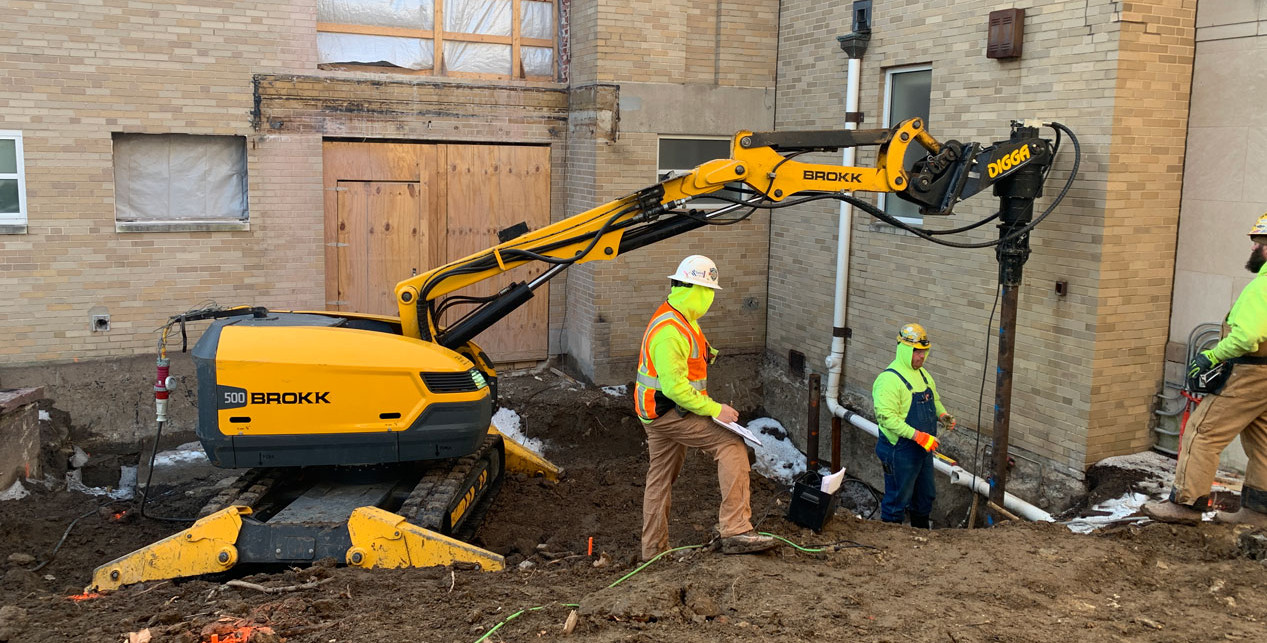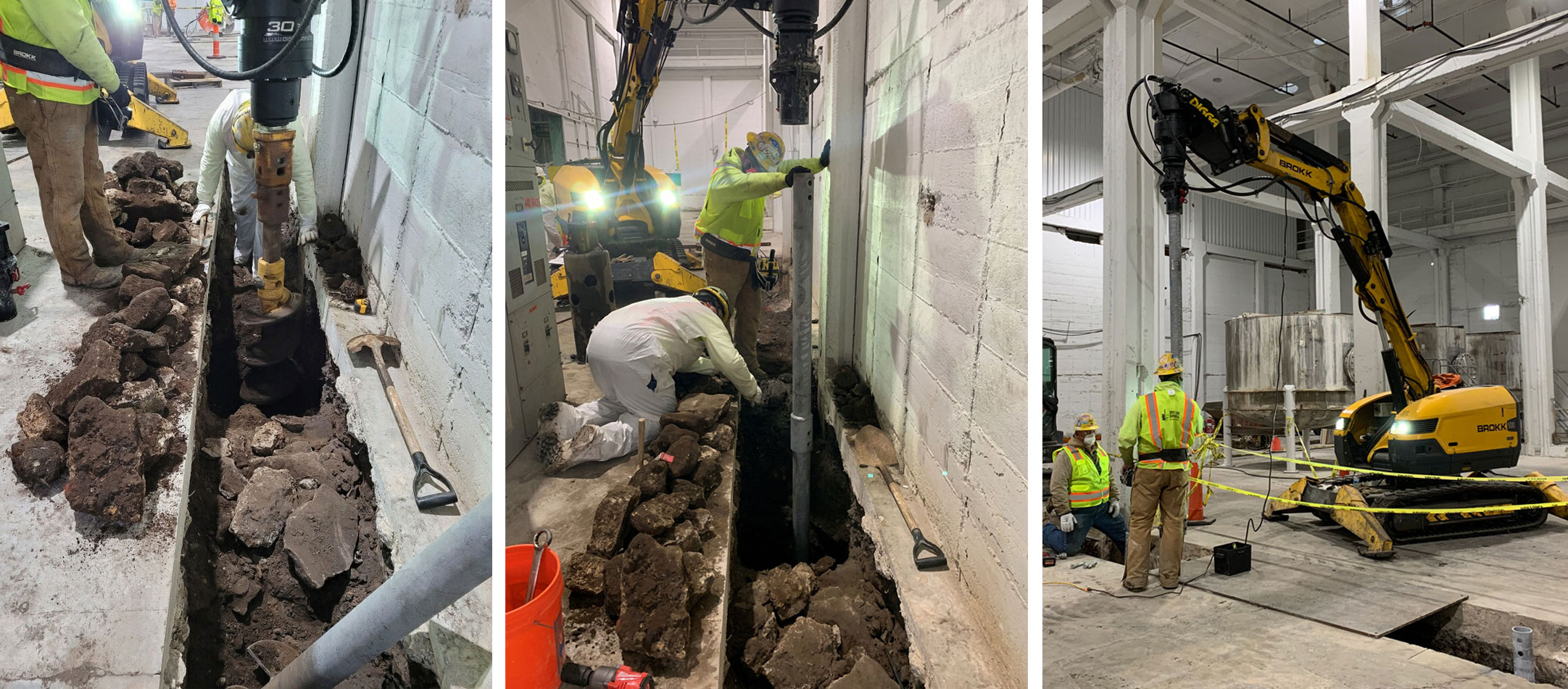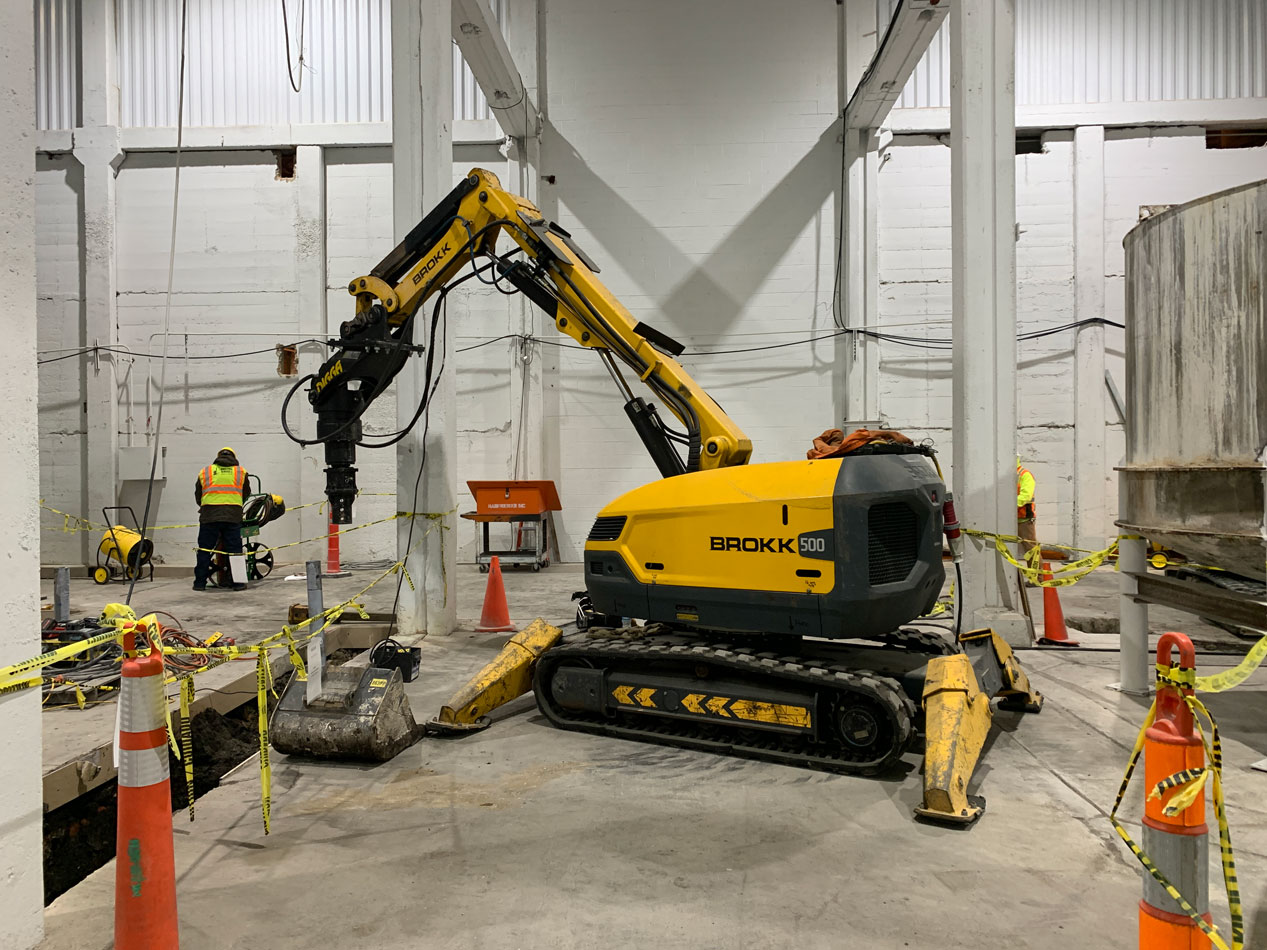Pier-less Power

27 December 2022 News articles
Remote-Controlled Demolition Equipment Solves Challenging Helical Pier Application
When it comes to deep foundation systems, helical piers are gaining traction with contractors across the country. This anchoring method offers minimal ground disturbance and leaves no spoils. There’s also no cure time involved, allowing immediate loading and accelerated project timelines. However, some applications have site-specific challenges, such as emission-restricted spaces or low floor loads, that limit equipment options.
Drilling Service Co. of St. Louis faced this situation on a warehouse retrofit near the city’s The Hill neighborhood. The location required zero emissions, so they turned to Brokk for a powerful electric solution. The BROKK 500 provided the necessary torque and maneuverability to help overcome several unforeseen challenges and complete the project on time and within budget.
Reputation for Innovative Tech Solutions
The brief seemed straightforward — retrofit a 100-plus-year-old manufacturing facility to support new equipment with heavier loads. However, site-specific challenges resulted in a more complex project. The single-story warehouse — located in a traditionally industrial neighborhood near the river — likely sat on contaminated soil, requiring limited spoils. Additionally, the facility wouldn’t allow the use of diesel-powered equipment within the building. This meant the contractor would need to find an electric solution.
The project’s general manager approached Drilling Service Co. based on their long history of delivering intelligent, efficient and effective underground solutions. The family-owned company, now in its third generation, has served the St. Louis area for 66 years. During that time, the company invested heavily in people and cutting-edge technology, embracing new methods to provide safe, efficient results.
For a company synonymous with quality, the warehouse retrofit presented a unique opportunity to explore a new process — robotic helical pier installation.
“At heart, we’re a company of problem solvers who always look for new ways to increase safety and efficiency,” said Kyle Murphy, project engineer for Drilling Service Co. “Everyone on the team brings their best ideas to the table. When we were approached with this project, we recognized an opportunity to explore new equipment options.”
Installing helical piers requires a robust hydraulic system and a specialized drive head that provides downward force and rotational pressure. Drilling Service Co. would traditionally run the drive head from the auxiliary hydraulics of a mini excavator or skid steer, but the zero-emission requirement meant coming up with a creative solution. The project required driving large helical piers — 4.5-inch-diameter (11.4-centimeter-diameter) pipe with a 16-inch-diameter (40.6-centimeter-diameter) helical plate — 20-25 feet (6.1-7.6 meters) down to refuse on bedrock. After establishing the required loads, they reached out to Ideal Group, the helical pier designer and manufacturer, to discuss equipment options.
“Ideal connected us with Brokk,” Murphy said. “They were using a Brokk 520D to test their larger helical piers in confined spaces. Not only did it provide the necessary torque, but the unique arm design meant it still had enough downward pressure to operate in low-overhead situations. That wasn’t one of our concerns with this project, but the electric operation was.”
Drilling Service Co. worked with Brokk to arrange a one-month rental of a Brokk 500. Ideal Group provided a DIGGA WITH A 30ADS ANCHOR DRIVE HEAD and a custom mounting bracket that allowed the Brokk to deliver.
Brokk provided training for Drilling Service Co. employees at their St. Joseph, Missouri, demonstration and service center. The Drilling Service Co. team had extensive experience with hydraulic drilling equipment, which gave them some familiarity with the basic functions. However, working with the Brokk robot’s remote operation allowed them to stand back and observe the installation from a distance. The training covered specifics of the Brokk machine including maneuvering it, setting the outriggers, operating the arm and running the drive head.
Work Begins
With its team trained and the helical piers delivered, Drilling Service Co. was ready. The general contractor started by saw-cutting an approximately 2-foot-wide section in the 6-inch-thick (15-centimeter) floor slab running the length of each new grade beam to expose the soil below. However, the crew discovered a layer of urban rubble less than a foot below the slab.

“We were surprised to find grapefruit- to beachball-sized fragments of cement, brick and old rebar from demolished buildings,” said Mat Boster, project superintendent for Drilling Service Co. “The helical only has a small pitch. It could have advanced through gravel-sized rubble, but this was too large.”
Drilling Service Co. quickly revised their plan. Before installing the piers, they needed to pre-drill holes. Attaching a 16-inch-diameter (40.6-centimeter-diameter) core barrel and auger to the drive head, the team used the Brokk to drill to the soil below.
“The Brokk worked great for pre-drilling,” Boster said. “It cut through rubble quickly, so we didn’t lose much time, and had more than enough power for driving the helical piers.”
Once the Brokk cut through the rubble, the lead of the helical pier was driven through the soil until it reached bedrock. 5- and 10-foot (1.5- and 3-meter) sections were added as installation progressed. The team constantly monitored the drive head and hydraulic pressure for optimal torque output. The Brokk 500’s 23-foot (7-meter) reach allowed them to access helical pier locations that would have been challenging with monoboom equipment. This included reaching up, over or around existing equipment when necessary. Brokk’s 41kW motor was easily powered by a 100kW generator positioned outside the building.
With pier installation complete, Drilling Service Co. capped the end of each pipe. The general contractor then cast the capped pipe into a grade beam that was reinforced with rebar, becoming the foundation for the facility’s new equipment.
More than half of the 46 helical pier positions needed to be pre-drilled. Thanks to the professionalism of the team and the versatility of the Brokk, the work progressed quickly, allowing Drilling Service Co. to complete the entire project in just three weeks.

Stay updated!
Thank You!
Thanks for your message. We’ll answer as soon as possible!
// The Brokk team
